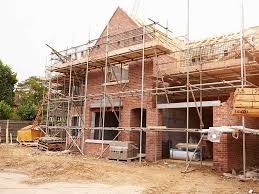Disasters are unpredictable, but the way buildings respond to them doesn’t have to be. With extreme weather events and seismic activity becoming more frequent, construction projects worldwide must be designed with resilience in mind. A reliable international construction company ensures that structures can withstand the elements and keep people safe, no matter the conditions.
Reinforced Building Materials That Absorb Impact Without Failing
Buildings take the brunt of disasters, so the materials they’re made of must be tough enough to handle impact without collapsing. Advances in global construction have introduced high-performance concrete, fiber-reinforced polymers, and flexible steel structures that can absorb shocks instead of breaking under pressure. In earthquake-prone areas, materials with elasticity help buildings sway rather than crumble, preventing large-scale devastation.
More construction firms are integrating self-healing concrete, which repairs small cracks before they turn into structural failures. This innovation extends the lifespan of infrastructure, especially in places exposed to heavy stress from earthquakes, floods, or extreme temperatures. By using materials that adapt rather than break, an international construction company can help governments create safer urban landscapes for generations to come.
Wind-Resistant Designs That Minimize Damage from Increasing Storm Intensity
Stronger storms mean greater risks for high-rise buildings, bridges, and coastal infrastructure. Wind-resistant design isn’t just about making structures heavier—it’s about shaping them to redirect wind force rather than resisting it. Skyscrapers in typhoon-prone regions now feature aerodynamic forms that channel wind around them instead of absorbing the full impact. This reduces pressure on the foundation and minimizes the risk of catastrophic failure.
For lower-rise buildings, reinforced roofs and impact-resistant windows prevent common storm-related destruction. Government construction projects in storm-prone areas increasingly require wind-rated materials to be standard in new developments. As hurricanes and tornadoes become more intense, global construction firms must prioritize stormproofing designs that don’t just survive harsh winds but actively work with them.
Strengthening Utility Infrastructure to Maintain Power During Emergencies
Disasters don’t just destroy buildings—they take down entire power grids, cutting off access to electricity, water, and communication. A reliable international construction company understands that utility infrastructure must be built to endure disruptions. Underground power lines, flood-resistant substations, and redundant grid systems ensure that even if part of the system fails, power can still be restored quickly.
Smart grids are another crucial upgrade. These systems automatically detect outages and reroute electricity to keep essential services running. Hospitals, emergency shelters, and water treatment plants rely on these systems to function when the rest of the city is in crisis. Governments worldwide are investing in disaster-resilient energy solutions, making this a key area where global construction expertise is essential.
Adapting Urban Spaces to Handle Unpredictable Climate Shifts and Natural Disasters
Urban planning can either prevent disasters from escalating or make them worse. Cities built without considering climate risks are vulnerable to floods, heatwaves, and earthquakes. A well-planned city incorporates drainage systems that prevent flash flooding, green spaces that absorb excess heat, and buildings designed to withstand environmental stress.
In flood-prone regions, raised foundations and permeable pavement reduce water damage. In areas at risk of extreme heat, reflective surfaces and shaded walkways lower temperatures, making cities more livable. Government construction policies increasingly mandate climate-responsive designs, ensuring that urban spaces don’t just react to disasters but actively mitigate their effects before they happen.
Smart City Planning That Reduces Damage in High-Risk Regions
Smart city planning goes beyond disaster response—it integrates technology to prevent crises from turning into catastrophes. Global construction projects now include real-time monitoring systems that track seismic activity, weather patterns, and infrastructure stress levels. These sensors send alerts when buildings show early signs of structural failure, allowing for quick repairs before problems escalate.
A forward-thinking international construction company also considers evacuation routes, emergency response coordination, and communication networks in its designs. In earthquake zones, automated building shut-offs prevent gas leaks. In coastal cities, smart flood barriers adjust to rising water levels. The goal isn’t just to withstand disasters but to outthink them, creating cities that are safer and more adaptable to future risks.
Modular Construction Methods That Allow for Rapid Post-Disaster Rebuilding
When disasters strike, rebuilding must happen quickly, but traditional construction methods take time. Modular construction solves this problem by using prefabricated building components that can be assembled on-site in days instead of months. Temporary housing, emergency hospitals, and replacement infrastructure can be built rapidly, allowing communities to recover faster.
Modular designs are also scalable, meaning they can be expanded or modified as needed. Many global construction firms now incorporate this approach into disaster recovery plans, ensuring that affected regions don’t just rebuild but do so with stronger, more adaptable structures. Governments looking for faster and more resilient rebuilding strategies increasingly turn to international construction companies that specialize in modular and flexible designs.









